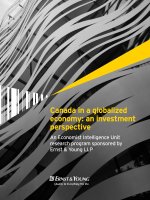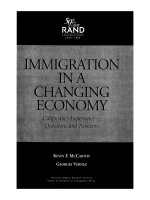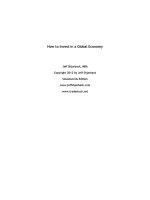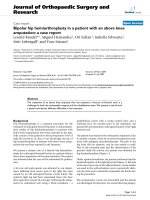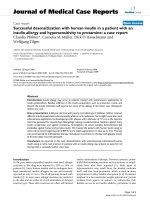Canada in a globalized economy: an investment perspective pptx
Bạn đang xem bản rút gọn của tài liệu. Xem và tải ngay bản đầy đủ của tài liệu tại đây (1.36 MB, 16 trang )
Canada in a globalized
economy: an investment
perspective
An Economist Intelligence Unit
research program sponsored by
Ernst & Young LLP
2 Canada in a globalized economy: an investment perspective
About the survey
In August and September 2011, the Economist Intelligence Unit conducted a global survey, sponsored by Ernst & Young
LLP, of 195 Canadian and non-Canadian executives, to ascertain and compare their attitudes towards expanding abroad
and to determine which factors drive their investment decisions. All the survey respondents are thoroughly familiar
with their companies’ foreign investment plans. Almost two-thirds (63%) are board members or C-level executives,
and around 40% are CEOs. In keeping with the survey’s geographic orientation, the bulk of the respondents are from
North America (66%). The remainder are from Asia–Pacic (16%), Western Europe (11%), the Middle East and Africa
(5%), Latin America (2%) and Eastern Europe (1%). More than half of the respondents (60%) work for companies
whose annual global revenue is US$500 million or less. Nineteen industries are represented, including nancial services
(15%), information technology (IT) and technology (15%), energy and natural resources (9%), education (8%),
manufacturing (8%) and professional services (8%).
1Canada in a globalized economy: an investment perspective
Figures from the United Nations Conference on Trade and Development
(UNCTAD) indicate that emerging markets’ share grew to more than half of
all global foreign direct investment (FDI) in 2010 — a trend likely to continue.
The Economist Intelligence Unit conducted a global survey of 195 Canadian and
non-Canadian senior executives to understand their perspectives on investment,
and found that a sizable share (38%) of respondents do intend to shift FDI from
developed to developing markets within ve years.
However, Canada also faces competition from its southern neighbour, despite
slow growth and political stalemate in the US. Entrepreneurship is one area in
which Canada is not perceived to be performing particularly strongly, despite
the country’s push to be recognized as a leader in this eld. This was further
conrmed by interviews with Canadian high-growth companies that nd more
opportunity in markets outside their home country.
This report explores the implications of changing investment patterns for
Canada, identies the key drivers of investment, and assesses the importance of
a country’s reputation for entrepreneurship in attracting investment.
The report’s key ndings include the following:
• Executives recognize the importance of emerging markets, but not all are
rushing to invest in them. One-quarter of the survey participants, Canadians
and non-Canadians alike, expect to shift some future foreign investments from
developed countries to emerging markets this coming year, and nearly 40% will
do so in the next ve years. Still, despite a volatile macroeconomic climate,
more than one-third of respondents say there will be no shift in investment
between emerging and developed markets for their companies.
• To the benet of developed markets, a favourable business operating
environment remains an important determinant of investment. For most survey
participants, a critical criterion for evaluating FDI targets was a favourable
business operating environment, which can still give developed countries an
advantage over developing countries in attracting investors.
• While appreciating its political and economic stability, few regard Canada as
offering a strong entrepreneurial culture. Non-Canadian respondents ranked
Canada a respectable fourth as an investment destination, chiey because
of its perceived political and economic stability. This undoubtedly reects
the US-tilt of the demographics among survey respondents. However, only
one-third regarded Canada as having superior market-growth prospects, and
very few respondents, including Canadians, felt it had an especially strong
entrepreneurial culture.
• Country “branding” can pay off by spurring inward investment. Ninety percent
of survey participants endorsed branding efforts by governments to boost
inward foreign investment. However, they also acknowledge that these efforts
cannot compensate for unattractive business conditions.
Executive summary
The 2008 nancial crisis and ensuing recession accelerated a shift in global
economic gravity from the developed to the developing world. As Canada,
the US and Europe grapple with debt problems and stagnant growth,
major emerging markets, such as Brazil, China and India, are prospering
conspicuously. How does this changing climate affect Canada’s future as a
favoured investment destination?
2 Canada in a globalized economy: an investment perspective
In a world turned topsy-turvy, Organisation for Economic Co-operation and
Development (OECD) countries’ real economic growth will be just 1.7% in
2011 and 1.6% in 2012, according to our forecasts. Even Canada, which fared
relatively well in the nancial crisis, has not escaped the slowdown; we expect
GDP growth of just 2% in 2012. By contrast, emerging markets as a group are set
to expand by more than 6% in both 2011 and 2012.
Table 1: The attractive and the slow
Population (m) Real GDP growth rate (%)
2010 2010 (actual) 2011 (estimates) 2012 (forecasts)
Developed markets
OECD Countries 2.9% 1.6% 1.3%
Canada 34 3.2% 2.2% 2.0%
UK 62.3 1.4% 0.9% 0.9%
US 310.2 3.0% 1.7% 2.0%
Developing markets
Brazil 190.8 7.5% 3.6% 3.8%
Chile 17.1 5.2% 6.7% 4.8%
China 1,312 10.4% 9.0% 8.6%
India 1,184 8.8% 7.9% 8.2%
Mexico 112.5 5.4% 3.4% 3.1%
Vietnam 87.8 6.8% 6.0% 6.6%
Source: Economist Intelligence Unit, 2011 gures.
Introduction:
The world economy’s
seismic shift
3Canada in a globalized economy: an investment perspective
Unsurprisingly, strong growth
prospects will have great implications
for investment. “The most important
determinants for foreign direct
investment are market size and market
growth,” argues Karl P. Sauvant,
Founder and Executive Director of the
Vale Columbia Center on Sustainable
International Investment at Columbia
University. “And for emerging markets,
expectations are that their dynamic
growth will continue.”
Companies are already factoring
this new order into their thinking
on foreign investment. Of Canadian
respondents, nearly 40% indicated that
they would shift foreign investments
from mature to emerging markets
within ve years. However, one-third
of all respondents still say they will not
change investment between emerging
and developed markets within ve
years, either implying condence in
markets in which they are currently
investing, or a perceived lack of
attractive markets (either emerging or
developed) to lure investors.
Do you expect your company
to shift its foreign investments
from emerging to developed
markets, or vice versa?
This year
Next
ve years
Yes, my company seeks to shift its investments from
developed to emerging markets.
25% 38 %
Yes, my company seeks to shift its investments from
emerging to developed markets.
11% 14 %
No, there will be no shift in investments between
emerging and developed markets.
52% 34 %
Source: Economist Intelligence Unit survey, 2011.
Table 2: A clear global shift
4 Canada in a globalized economy: an investment perspective
The ow of FDI, however, highlights a clear shift in the centre of global economic
gravity. Overall, the recovery in global FDI post-crash has been anaemic. UNCTAD
estimates that international investment ows dropped by around one-third
from US$2 trillion in 2007 to US$1.3 trillion in 2010. However, there has been
only a scant decrease in the ows going to the emerging markets. In 2007, the
FDI in emerging markets was US$664 billion, compared with US$642 billion in
2010—which represents a relative decline of barely 3%. Today, emerging markets
account for more than half of all FDI, compared with one-third as recently as
2007 (see chart, below).
Chart 1: Global FDI ows by country groups (US$ billions): 2005–10
2,500
2,000
1,500
1,000
500
0
2005 2006
Developed Emerging
2007 2008 2009 2010
Our survey respondents — both Canadian and non-Canadian — who already invest
abroad expect palpable benets from doing so, and nearly 40% of those polled
said they expect their companies’ foreign earnings to increase substantially
(by 20% or more) over the next ve years. Among survey participants overall,
close to one-fth anticipate a 20% or greater boost in foreign-derived prots
this year, and 44% see a substantial gain over the next ve years, compared with
the previous ve. In an environment in which Canadian and foreign companies
estimate greater return from investment in emerging markets, Canada faces
tough competition to lure investors.
5Canada in a globalized economy: an investment perspective
Factors driving
investment
decisions abroad
Although reasons for investing abroad
certainly vary across companies,
there are two primary drivers pushing
corporate investors into emerging
markets: the decision to efciently
outsource production and the desire
to tap fresh markets. “You look for
lower cost for the same output or more
output for the same cost,” points out
Steven N. Kaplan, Neubauer Family
Professor of Entrepreneurship and
Finance at the University of Chicago.
Cost-effectiveness is likely to weigh
heavily into any investment decision.
Additionally, with a burgeoning middle
class, emerging markets’ fast-growing
retail and wholesale sectors are
especially enticing for companies
seeking to grow their sales. Indeed,
most Canadian executives in the
survey cite larger markets (60%)
and growth markets (52%) as the
primary benets of investing abroad.
Yet, when asked what they value most
in an investment decision, Canadian
executives cited a favourable business
operating environment as their top
choice (34%), followed by large
market size (29%). Non-Canadian
respondents agree: they consider
a favourable business environment
(cited by 42%) as the most valuable
characteristic of an investment
destination, followed by a large market
size (30%).
Indeed, while high-growth in foreign
markets may be a reason to venture
abroad, it may not be enough to keep
investors in if a business environment
poses regular hurdles. Luckily, this
offers a potential opportunity for
developed markets to lure investors in
a climate that is otherwise favouring
emerging markets.
Table 3: Labour productivity growth
in selected countries*
Country 2005 2006 2007 2008 2009 2010 2011
Canada 1.8% 0.7% 0.1% -1.0% -1.2% 1.7% 0.6%
China 10.4% 11.8% 13.3% 8.9% 8.5% 9.7% 8.5%
US 1.3% 0.7% 0.8% 0.1% 0.3% 3.6% 1.2%
UK 1.1% 1.9% 2.0% -0.8% -3.3% 1.1% 0.2%
Vietnam 5.8% 5.3% 5.9% 3.6% 3.3% 4.5% 3.9%
Source: Economist Intelligence Unit.
* Dened by the EIU as the efciency of labour measured in terms of output per
worker (that is, real GDP per person employed).
6 Canada in a globalized economy: an investment perspective
With their home markets sluggish, more developed-country companies have
come to rely on foreign markets to spur growth. For instance, when Vodafone
PLC reported in July 2011 that its revenue had risen by 3.5% in the rst quarter
despite a stagnant UK economy, it credited emerging-market sales, especially
in Turkey, India and South Africa. Indeed, this optimism regarding emerging
markets — BRIC countries (Brazil, Russia, India and China) in particular — is
reected in top investment destinations cited by both non-Canadian and
Canadian respondents in our survey.
Table 4: Top ve investment destinations
FDI inow in 2010:
UNCTAD report
Non-Canadians in Economist
Intelligence Unit survey 2011
Canadians in Economist
Intelligence Unit survey 2011
US China Canada
China India US
Hong Kong SAR US China
Belgium Canada India
Brazil Vietnam Brazil
Source: UNCTAD; Economist Intelligence Unit survey, 2011.
For the non-Canadians in the survey,
the most appealing foreign investment
locales were generally no great
surprise. Less predictable was that
16% would make Vietnam — a country
that ranks 30th on UNCTAD’s FDI ow
tabulations — their top choice, tying
it with Brazil. This likely reects the
“China plus one” strategy adopted
by many companies, particularly
manufacturers, to diversify overseas
operations in Asia to counter climbing
labour costs in China.
As Vietnam surges in popularity, other
rms are beginning to recognize that
this country of 90 million people has
attractive features beyond its close
proximity to China. The prospect
that Asian emerging markets, whose
young populations enjoy mounting
purchasing power, will cultivate a
generation of consumers has inspired
some interesting investments.
In April 2011 Kohlberg Kravis
Roberts & Co., a US private equity
rm, took a 10% stake in Masan
Consumer Corp., Vietnam’s leading
producer of sh, soy, chili sauce and
branded noodles, in the country’s
largest-ever deal of this type, valued at
US$159 million.
Hitting a BRIC wall:
Canada’s competition
7Canada in a globalized economy: an investment perspective
Meanwhile, the home bias of Canadian
companies in particular who ranked
their country as the top investment
destination was striking — although
87% of all survey participants did
patriotically describe their home
countries as good places to invest.
Understandably, much of this
support for the “home team” can be
attributed to Canada’s stable business
environment — cited by both domestic
and foreign investors. Yet the survey
suggests that this tendency also stems
in part from an uneasiness regarding
investing overseas.
For one-quarter of the Canadian
executives, political instability was
the greatest concern about expanding
abroad, while 28% of Canadian
respondents cited macroeconomic
instability as a challenge. On an
operations level, 29% cited doubts
about being able to nd a qualied
workforce. And as a deal-breaker,
nearly one-third expressed skepticism
about being able to earn a high enough
return on investment to make the
whole endeavour worthwhile. Yet,
while most of these challenges have
long been common to many emerging
markets, some are also a growing
problem in parts of the developed
world. Meanwhile, the opportunities
developing markets offer are
substantial. While their home country
still ranks highly as one of the primary
investment destinations among
Canadian rms, there is no doubt that
competition from BRICs will continue.
8 Canada in a globalized economy: an investment perspective
Emerging markets may be
the leading contenders in the
battle for FDI, but certain
developed countries, such
as Canada, should not be
discounted. Revealingly,
the largest share of survey
respondents (42%) declared
that the single most valuable
characteristic of a foreign
investment destination
was a favourable business
operating environment.
Although a majority (60%)
of respondents who indicated
this hail from North America,
20% of these respondents
are based in Asia-Pacic.
OECD countries can still have a
distinct advantage, given their sizable
local markets, high income levels,
well-developed infrastructures,
established legal and nancial systems,
sophisticated business support
services (including an educated
workforce) and (comparative)
political stability. Canada scores
highly in all categories of our business
environment ranking. Overall, Canada
places fourth out of 82 countries,
ahead of the 11th-ranked US and far
ahead of China (50th). Hence, the
sheer speed of a foreign market’s
growth may not be the dominant
investment criterion, even for
companies that prioritize rapid growth
(See sidebar 2, “ Why should high-
growth tech rms accept borders?”).
However, expanding into developed
markets is not without its own set
of challenges, as the survey attests.
For one thing, a mature business
infrastructure can be as much a curse
as a blessing, especially if it entails
a rigid labour market, stiff taxes and
strict regulation. And an unfavourable
business climate of course sties
entrepreneurship, a pivotal
consideration for companies hoping to
develop and grow their businesses.
A mere 6% of survey participants
described Western Europe, whose
labour laws are considered to be
particularly onerous, as “highly
entrepreneurial”; a similar number of
respondents deemed the Middle East
and Africa to be an entrepreneurial
region. North America and Asia fared
far better, with 47% and 37% of survey
participants, respectively, rating
them as “highly entrepreneurial.”
By no coincidence, these regions
are the favoured investment
targets of both Canadian and
non-Canadian executives.
The continuing
case for investing
in Canada
Some developed markets are notably
better than others at attracting foreign
investors. That has been true, up to
a point, of Canada; roughly one-fth
of its business assets are foreign-
controlled (chiey by US companies).
Among the non-Canadians in our
survey (a group that, admittedly,
includes a hefty contingent from the
neighbouring US), the country ranked
fourth for “most-preferred” investment
destination (selected by 21%). More
than one-third of non-Canadian survey
respondents (37%) were “positive”
about Canada as a place to invest, and
28% were “very positive.”
Canada’s considerable attractions
for foreign companies (including its
neighbours across the border) include
a long legacy of welcoming foreign
investors (although not always with
open arms ); a record of brisker
growth than any other G7 country;
moderate corporate income taxes
(of 15% as of 2012); advanced R&D
facilities; a healthy tech sector; a well-
educated workforce; an abundance
of natural resources; a high-quality
lifestyle; and convenient proximity
to the large market the US offers,
ready access to which is assured
by the NAFTA. (Canada’s assorted
attributes are such that UNCTAD
ranks it 14th out of 141 countries in
terms of FDI potential.) Canada can
even boast a strong entrepreneurial
ethos, according to the 2010 Global
Entrepreneurship and Development
Index (GEDI), which placed Canada
second, one place ahead of the US.
Why developed markets
can still have an edge
9Canada in a globalized economy: an investment perspective
Although they do not recognize
Canada as having a particularly strong
entrepreneurial environment, our
survey respondents agree with much
of the above assessment. In addition to
macroeconomic and political stability,
non-Canadians point to infrastructure
(70%), availability of qualied labour
(61%) and business climate (49%) as
benets of investing in the country.
Nevertheless, Canada, like other
developed countries, has lost ground
in attracting foreign investors to
emerging markets over the years. In
UNCTAD’s list of top country recipients
of FDI, Canada placed third in 1980,
eighth in 1990, fth in 2000, and
fell off the top-ten list completely
in 2010. This was in spite of a 2.6%
year-on-year gain in inward FDI, to
CDN$561.6 billion, largely linked to
the global commodities boom.
The Conference Board of Canada,
warning that diminished FDI is
damaging the country’s productivity
and economic performance, has
urgently recommended that more
be done to entice foreign investors.
In a telling analysis published in
April 2011, the board used an “inward
FDI performance index” — the ratio of
a country’s share of global FDI to its
share of global GDP — to determine
that the ratio of Canada’s inward
FDI to its share of global GDP has
hovered between 1.1 and 1.2 since
1995. That is, the country punches
slightly above its weight globally in
inward FDI. Contrast that performance,
however, with Canada’s ratio of an
astonishing 6 in 1970 — a gauge of just
how alluring the country once was to
foreign capital.
Canada’s
shortcomings as
an investment
destination
Thirty-nine percent of foreign
investors in the survey say the primary
benet of investing in Canada is that
it provides easier access to North
America. Indeed, despite the relative
volatility of the US compared to the
more consistent performance of its
less vocal northern neighbour, the US
still invites a feeling of condence.
Joe Overdevest, a portfolio manager
at Pyramis Global Advisors, asserts
that foreign corporate investors feel
comfortable in Canada because the
accounting system is the same as in
the US. Moreover, Mr. Overdevest says,
“The capital markets are connected
to the US, as well as to the UK.” Close
links with two of the largest nancial
centres in the world is certainly a plus.
A particular striking outcome of
the survey was the low degree to
which respondents regarded Canada
as having a highly entrepreneurial
environment — a factor that more than
two-thirds of respondents agreed was
very important or important to their
company’s foreign investment decision.
While 83% of all respondents indicate
that North America offers a strong
entrepreneurship environment, this
may be an attribute limited to the US.
Despite Canadian prime minister
Stephen Harper’s proclamation
that 2011 was the “Year of the
Entrepreneur” in Canada, and
notwithstanding the country’s high
GEDI ranking, just 10% of the Canadian
executives surveyed — most of whom
say they invest in their domestic
market — felt that the country was
“much” better than other nations at
encouraging entrepreneurship.
The proportion of the non-Canadians
canvassed who agreed with that
assessment was even smaller, at
6%. However, 33% of Canadian
respondents and 32% of non-Canadian
respondents did acknowledge that
Canada was better than other potential
investment destinations in nurturing
entrepreneurship — although this still
means that half of all respondents
regard Canada as average or worse in
this area.
10 Canada in a globalized economy: an investment perspective
Table 5: Non-Canadian respondents’ perceptions of Canada
In your opinion, relative to other prospective investment destinations
for your company, what is your perception of Canada in the following
areas? Rate on a scale of 1 to 5.
1
Canada is
much stronger
than other
countries
2 3
Canada
is about
the same
compared
to other
countries
4 5
Canada is
much weaker
than other
countries
Don’t
know
Total
Entrepreneurship 6 % 32 % 43 % 7 % 4 % 8 % 100 %
Business operating
environment
(including taxes
and regulation)
14 % 35 % 30 % 8 % 6 % 7 % 100 %
Market-growth
opportunities
2 % 33 % 31 % 19 % 6 % 8 % 100 %
Macroeconomic
Stability
30 % 48 % 14 % 6 % 0 % 2 % 100 %
Source: Economist Intelligence Unit survey, 2011.
Dan Shimmerman, CEO of Toronto-based Varicent Software,
calls Mr. Harper’s program to promote entrepreneurship
“well-intentioned” and agrees that “branding will galvanize
people.” Nevertheless, he remains cautious. “[The program]
runs the risk of not solving the real problem, which is more
deeply rooted,” he says.
As Mr. Shimmerman sees it, the issue is cultural.
“We are a nation built on natural resources, and we’re
passive–aggressive when it comes to other areas, such
as technology.” He claims it is extremely frustrating to
start and expand a tech enterprise in Canada (Varicent
has ofces in eight countries and does business in
over 30 countries), and points to a lack of would-be
entrepreneurs who are focused on long-term growth and
value creation, as well as a dearth of investors to help fund
these endeavours.
11Canada in a globalized economy: an investment perspective
Table 6: Canadian respondents’ perceptions of Canada
In your opinion, relative to other prospective investment destinations for
your company, what is your perception of Canada in the following areas?
Rate on a scale of 1 to 5.
1
Canada is
much stronger
than other
countries
2 3
Canada
is about
the same
compared
to other
countries
4 5
Canada is
much weaker
than other
countries
Don’t
know
Total
Entrepreneurship 10 % 33 % 31 % 19 % 6 % 1 % 100 %
Business operating
environment
(including taxes
and regulation)
22 % 38 % 24 % 11 % 5 % 1 % 100 %
Market-growth
opportunities
9 % 28 % 34 % 20 % 8 % 1 % 100 %
Macroeconomic
Stability
60 % 28 % 10 % 2 % 0 % 0 % 100 %
Source: Economist Intelligence Unit survey, 2011.
Considering the competition from the US, which attracts
foreign investors through a strong tradition of free
enterprise and skilled labour, Canada is relatively weak in
the eld of entrepreneurship. Canada’s shortcomings are
many compared with the US: strict labour regulations;
expensive living costs; a smaller market; higher taxes; and a
lack of ready venture-capital nancing. Many of these have
been acknowledged by Mr. Harper himself. Competing with
the US will remain a challenge and, as emerging markets
take strides in improving their business environment,
Canada must do more to lure in investors.
Canada has much to offer beyond its convenient location
north of and privileged access to the US market. The
country has performed well post-2008 compared to other
OECD countries and its stable political environment,
large skills base, well-developed infrastructure and
welcoming attitude towards foreign investment continue
to entice investors. Although Canada’s entrepreneurship
environment remains strong by some measures, judging
by our survey respondents, it must respond to barriers
perceived by investors and high-growth companies. In
today’s climate, Canada must rebrand itself. (See sidebar 1,
“Like companies, countries need a strong brand.”)
12 Canada in a globalized economy: an investment perspective
Although emerging markets
may yet face hurdles on their
road to development, there is
no doubt that a fundamental
realignment is underway in the
global economy, reected in
an ongoing shift in investment
ows from the developed to the
emerging world. Both developed
and developing markets offer
businesses opportunities
for growth and expansion,
depending on what companies
deem important to their overall
strategy. How does a company,
then, make the most of this
sea change? Here are a few
recommendations deriving from
the survey and related research:
• Seize the decade: Burgeoning
emerging markets offer a great
opportunity to capture real revenue
growth and/or bolster manufacturing
margins — especially for companies
domiciled in developed countries
with sluggish growth. In order to
seize these opportunities, companies
should not underestimate the value
of rst-mover advantage. As Rupert
Murdoch observed, “The world is
changing very fast. Big will not beat
small anymore. It will be the fast
beating the slow.”
• Pick your spot. Not all emerging
markets are created equal. In
the current frenzy to invest,
this truism can be forgotten.
But companies that grasp the
underlying nature of today’s global
economic transformation will have
an advantage. Signicantly, the
63% of Canadians in the survey
who regard their companies as
stronger at foreign investing than
their competitors give Asia as
their top investment destination,
compared with 49% for all other
survey participants.
• Match your market. No algorithm for
how to approach foreign investing
would work for all companies.
But one common principle that is
overlooked remarkably often is that
you have to sell overseas customers
something they actually want to buy.
Or, as the University of Chicago’s Dr.
Kaplan puts it, “Smart companies
expand where there is a market for
their products.” And this means
that the one metric that ultimately
matters is sales.
Conclusion
Just as companies use branding to
market their products to consumers,
countries increasingly use branding to
market themselves to foreign investors.
Around 90% of the executives polled
agreed with the proposition that
government efforts play an important
part in providing a positive brand image
for their countries as a place to invest.
In the same vein, 82% asserted that
countries ought deliberately to cultivate
a brand to attract foreign investment.
But do such marketing campaigns
really work? In the June 2011 issue
of the Economic Journal, two Oxford
University economists, Tornn Harding
and Beata S. Javorcik, review data
from 124 countries and conclude that
investment promotion can indeed
lead to heightened foreign-investment
inows. However, the results vary widely.
Investment-promotion activities appear
to be most fruitful for countries seeking
to counteract a negative impression
about business conditions. Perhaps that
is why the study found that investment
promotion seems to work best for
developing, rather than developed
states. The strategy appears to pay off in
particular for emerging markets that are
seen as being ensnared in red tape and
mired in misinformation.
Investment-promotion agencies (IPAs)
have scored noteworthy coups. Dr.
Sauvant notes that one ploy is for a
developing country to entice a agship
company to become a direct investor
and thereby provide an unofcial seal of
approval and attract other investors.
For example, Costa Rica, an en vogue
tourist destination for backpackers,
succeeded in 1996 in persuading Intel to
build a US$300 million semi-conductor
plant in the tiny Central American
country. Almost a decade later, the
World Bank’s Multilateral Investment
Guarantee Agency, which promotes
investment in developing countries,
found that the project had delivered
large direct and indirect economic
benets to Costa Rica, including
elevating its global standing as a worthy
site for foreign investment.
Canada, of course, has many more in-
built attractions for investors than Costa
Rica, yet it also appreciates the value
of strategic brand marketing. Invest in
Canada, which operates a network of
foreign-investor recruitment ofces that
Like companies, countries need a strong brand
13Canada in a globalized economy: an investment perspective
Why should high-growth rms
accept borders?
“If you play in a high-growth [technology] sector, such
as digital media, the world is your oyster, because you’re
not constrained by the global economy,” argues Peter
Conrod, Vice-President of Client & Business Strategy
for Royal Bank of Canada. This is one oyster, moreover,
that can be shucked open different ways, as the foreign
investing experiences of a dynamic pair of Canadian
high-tech enterprises illustrate. As the producers of an
inherently “disruptive,” game-changing product, they,
surprisingly, do not feel constrained by convention.
Varicent Software, fourth on PROFIT magazine’s list
of Canada’s 200 fastest-growing companies, makes an
innovative online compensation-and-sales-performance
management tool. “Even in tough economic times, our
solution does well because it addresses a business need,”
says CEO Dan Shimmerman.
Nor does Varicent conne its ingenuity to software.
Although based in Toronto, the company started out
selling its product in the US and followed with expansion
into Europe and Asia. Not until four years after it was
founded did it start selling its software in its home
Canadian market.
“We don’t spend too much time on analysis to determine
which markets to go to,” Mr. Shimmerman condes.
Instead, the company makes “calculated bets.” This is not
as casual a process as Mr. Shimmerman makes it sound.
“We set clear expectations and watch [sales] milestones,”
he says. If the rm fails to meet them, it will modify its
plans or pull out of a country. Currently, Varicent has a
presence in eight countries.
One example of Mr. Shimmerman’s intuitive decision-
making style is the way he chose to establish a regional
headquarters in Asia. To him, it simply made sense for
the rm to open an outpost in this booming region. So,
the only question became whether to locate it in Hong
Kong or Singapore. He chose Hong Kong.
Edmonton-based Yardstick Software Inc., 17th on the
PROFIT list of rapid growers, offers web-based testing
services for certication and licensing. Chris LaBossiere,
the co-founder and co-CEO, does not even bother to look
at such traditional metrics as market size and growth
rate when making foreign-investment decisions.
“We sell the product where the regulatory environment
creates a market for it,” he explains. And that may well
be in a developed country with technologically advanced
customers, whose language, culture and laws make them
suitable candidates for Yardstick’s services. So, rather
than venturing into emerging markets, Yardstick has
targeted Australia, New Zealand, Singapore, the UK and
the US.
Although their approaches to foreign investing may
seem rather unorthodox, these high-growth companies
follow the opportunities they see. “No doubt, that’s one
reason these are high-growth companies to begin with,”
suggests Royal Bank’s Mr. Conrod.
spans 150 cities around the world, is a slick marketer of Canada’s
charms to foreign corporations. Moreover, all ten of Canada’s
provinces and several of its major cities now have their own IPAs
that tout the business attractions of their respective locales.
However, for all their successes, IPAs can only do so much.
“Promotional efforts can make people take a look, but, at
the end of the day, it’s all about the numbers,” contends
Dr. Kaplan. As much as they advocate promotional efforts, the
survey participants tend to concur. A decent majority (60%)
acknowledges that market data, such as size and growth,
ultimately trump branding razzle-dazzle.
In any event, IPAs are now confronted by the same conundrum
as product merchandisers: brand saturation. As Dr. Sauvant
notes, “Efforts to attract investment have increased globally, both
through national investment promotion agencies and sub-national
units, so the world investment market has become much more
competitive.” That is all the more reason that, if a country has a
good story to tell, as Canada does, it is worth telling it well.
• Do not dismiss developed markets. Emerging markets’
soaring growth and shining prospects may dazzle some CEOs,
but more risk-averse investors are hesitant. In this regard,
some slower-growing established nations still offer benets:
political and economic stability, developed infrastructures,
educated workers, R&D facilities, afuent consumers — the list
goes on. It may be worth checking those off before shifting
too much investment to emerging markets. China, notably,
more than doubled its own investment in Canada from
CDN$5.7 billion in 2008 to CDN$14.1billion last year.
• Take advantage of investment-promotion agencies. For a
start, they can supply data and context to help to take some
of the “foreign-ness” out of foreign markets when mulling
an investment decision. Moreover, as Columbia University’s
Dr. Sauvant notes, amid intense global competition for
FDI, “More than ever, investment locations have to be on
their toes in terms of providing an interesting investment
opportunity.” It can pay off, literally, to check with the
agencies (See sidebar 1).
Contact us
To learn more about our services for entrepreneurial companies, please contact
one of the following professionals.
Colleen McMorrow
Canada Strategic Growth
Markets Leader
416 943 2718
Western Canada
Joe Healey
204 954 5568 |
Bruce Picton
780 638 6640
David Van Dyke
403 206 5177
Ron Voyer
604 684 7598
Central Canada
Colleen McMorrow
416 943 2718
Greg McCauley
519 571 3319
Eastern Canada
Luc Charbonneau
514 879 2638
Sandy Goldberg
613 598 4810
Lynn Healey
709 570 8866
Andre Vezina
418 640 5127
Ernst & Young LLP
Assurance | Tax | Transactions | Advisory
About Ernst & Young
Ernst & Young is a global leader in assurance,
tax, transaction and advisory services.
Worldwide, our 152,000 people are united
by our shared values and an unwavering
commitment to quality. We make a difference
by helping our people, our clients and our wider
communities achieve their potential.
For more information, please visit ey.com/ca
Ernst & Young refers to the global organization
of member firms of Ernst & Young Global
Limited, each of which is a separate legal entity.
Ernst & Young Global Limited, a UK company
limited by guarantee, does not provide services
to clients.
ey.com/ca
© 2011 Ernst & Young LLP. All rights reserved.
A member firm of Ernst & Young Global Limited.
1110-1294652
This publication contains information in summary form, current
as of the date of publication, and is intended for general
guidance only. It should not be regarded as comprehensive or a
substitute for professional advice. Before taking any particular
course of action, contact Ernst & Young or another professional
advisor to discuss these matters in the context of your particular
circumstances. We accept no responsibility for any loss or
damage occasioned by your reliance on information contained
in this publication.
